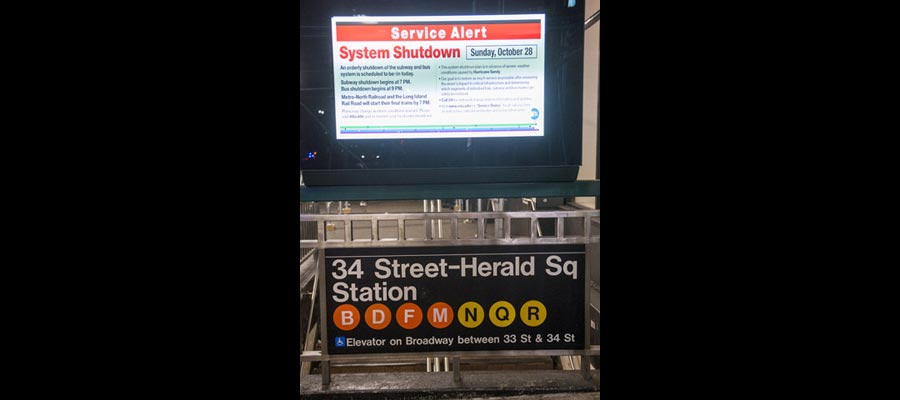Sandy. Such a nice, friendly-sounding name. But if you asked the residents of the eastern US what they thought about Hurricane Sandy, I’m sure most reactions would be unprintable. The largest Atlantic hurricane on record in terms of size (winds spanning 1800 kilometers!), Sandy became known in the US as the “Frankenstorm.” Why? Not only because it occurred so close to Halloween, but also because as it was barreling up the Atlantic Coast, it rendezvoused with a snowstorm coming from the western US and a cold front coming down from the Arctic. To make matters worse, all this was taking place at the time of the full moon, when tides are higher than normal. It was truly a superstorm.
What other records did Sandy set? It had the lowest barometric pressure, has killed 185 people so far (probably not all the dead bodies have been recovered yet), and will cost at least $52.4 billion (second highest hurricane damage after Katrina). Sixty million people in nine states were ordered to evacuate. Over 8 million people lost electricity in the US, and it has still not been come back on for over two million people. Most public transportation in the Eastern US, including trains, planes, subways, etc., were shut down, and is still being restored in New York and New Jersey. Many states in the Midwest received record snowfalls.
Sandy developed south of Jamaica and went on to devastate Jamaica, Haiti, the Dominican Republic, Puerto Rico, the Bahamas, 24 states in the United States and Canada. It particularly wrecked havoc in New Jersey and New York. Possibly the only positive thing you can say is that this time the United States and local governments were prepared well in advance, although as of Monday, 5 November, 30,000 to 50,000 people in the New York area are still homeless from the storm, which is particularly tragic since nighttime temperatures are 10 degrees below normal.
There are so many stories from Sandy that there’s simply no space to tell them all, but some of the more memorable occurrences have to be mentioned. Even before Sandy made landfall, it claimed its first victims. Bounty, a 180-foot tall ship which was a replica used in the making of the 1962 movie Mutiny on the Bounty, foundered in 30-foot waves off the coast of North Carolina and went down. One crew member was killed, and the captain remains missing.
The Jersey Shore suffered the most severe winds and surf from Hurricane Sandy, and the most damage from the storm. 50 feet (15 meters) of the Atlantic City Boardwalk was washed away. Approximately two dozen oceanfront houses in one town were completely removed from their foundations and destroyed. Much of two piers in a town called Seaside Heights collapsed into the ocean due to intense waves. Most of the rides in the piers’ amusement parks were destroyed, including their roller coasters.
The effects of Hurricane Sandy in New York were severe, particularly in New York City, its suburbs, and Long Island. Sandy’s impacts included the flooding of the subway system and many suburban communities. All road tunnels entering Manhattan, except for the Lincoln Tunnel, and most bridges were closed. The New York Stock Exchange was closed for two days. Numerous homes and businesses were destroyed by fire, including over 100 homes in Breezy Point, Queens. Additionally, a large construction crane atop a 97-story building, which will be the tallest residential building in New York, partially collapsed. Many blocks around the area to be evacuated for six days.
Space Shuttle Enterprise, on board the flight deck of the Intrepid Sea, Air & Space Museum in the Hudson River, was damaged. The inflatable structure of the shuttle appears to have first deflated and then been torn by the high winds.
Of course, many events had to be canceled due to the emergency. New York’s Village Halloween Parade, held annually on October 31, was cancelled due to blackout conditions in Greenwich Village.
After many complaints that running the race through affected areas would seem insensitive and would put further pressure on police and other service workers who would be better deployed in the recovery efforts, Mayor Bloomberg announced on the late afternoon of November 2 that the New York City Marathon had been cancelled. The event was to take place on Sunday, November 4. Marathon officials said that it will not be rescheduled. But because over 20,000 runners were already in the city, a lot of them ran the 26-mile course anyway. Other runners joined the thousands of volunteers helping the stricken residents of New York.
Of course, as is usual after catastrophes these days, a telethon was held to raise money for the victims. Featuring natives of New Jersey such as Bruce Springsteen and Jon Bon Jovi, it raised $23 million dollars.
But, as they say, a picture is worth a thousand words. There are millions of photos and videos of the storm on the internet, but I particularly recommend the large photos on the Atlantic magazine website: http://www.theatlantic.com/ infocus/2012/10/hurricane-sandy-after-landfall/100396/#, and for the aftermath: http://www.theatlantic.com/infocus/2012/11/hurricane-sandy-the-aftermath/100397/
Lastly, tomorrow, 6 November 2012, will be the United States’ presidential election. No one knows how Hurricane Sandy will affect the election, but there’s no doubt it will have an impact as it has already had on so many aspects of American life.
Debbie Gambrill
zdroj foto: dreamstime.com

